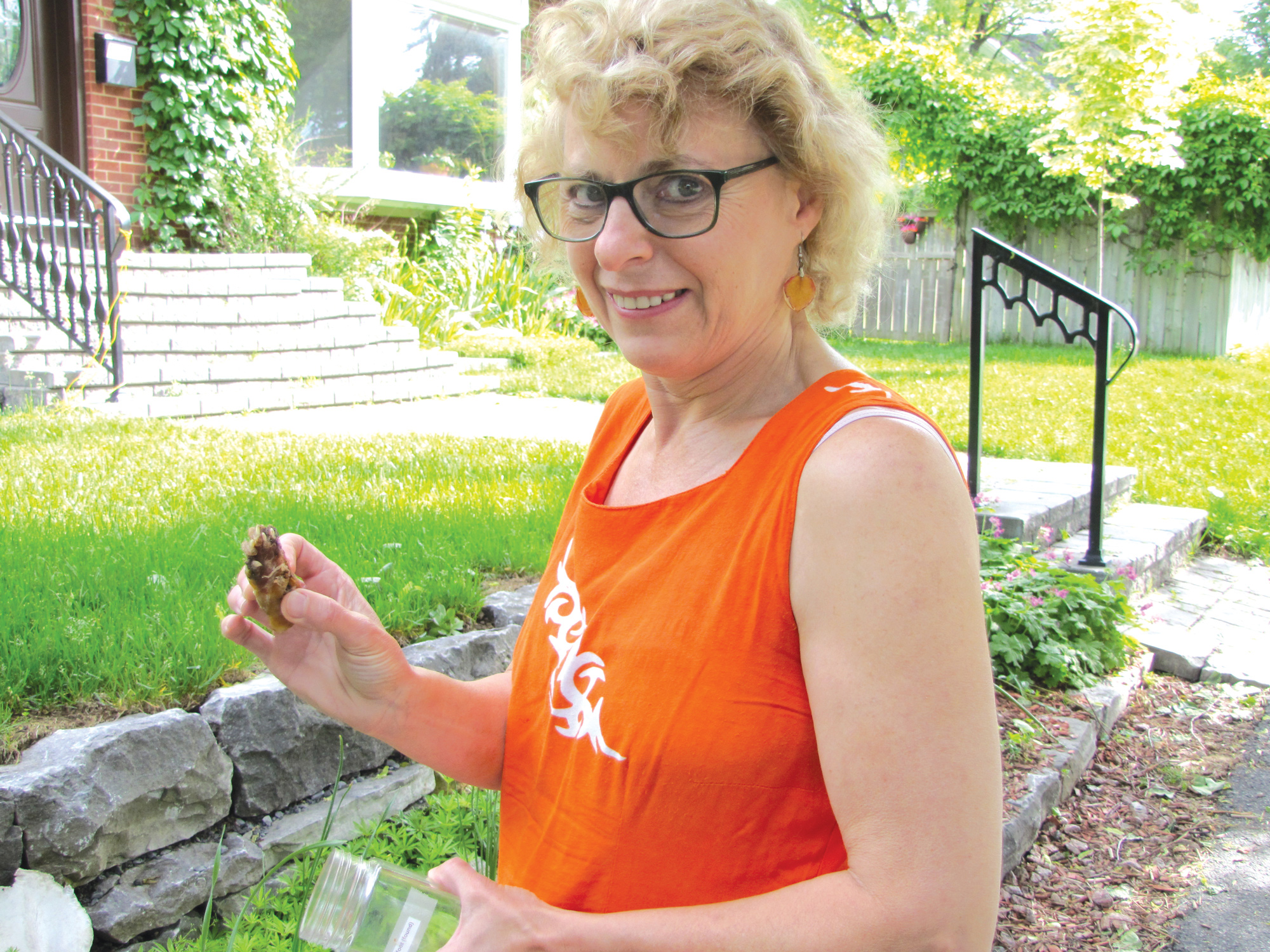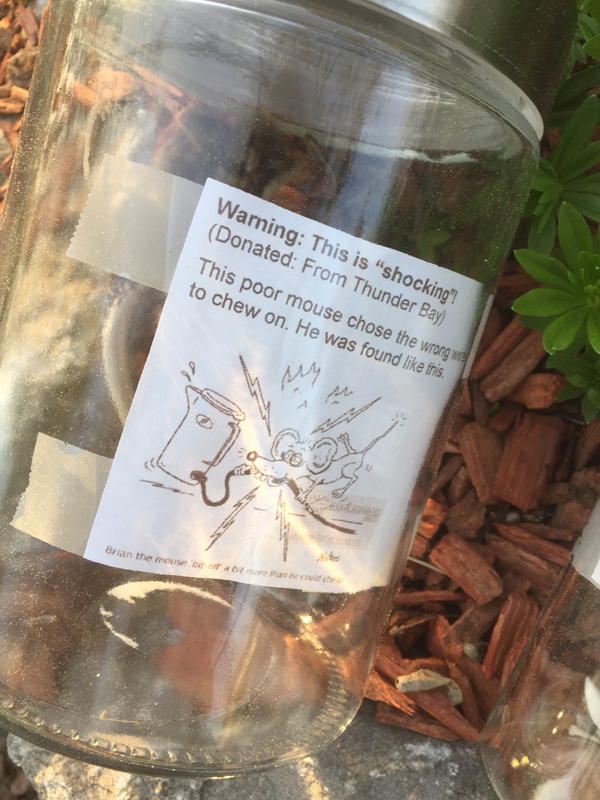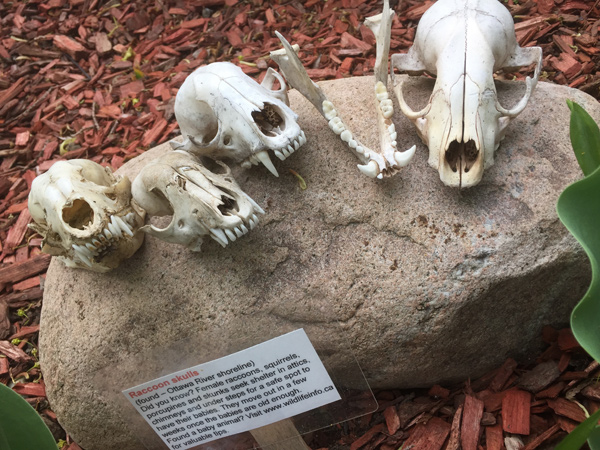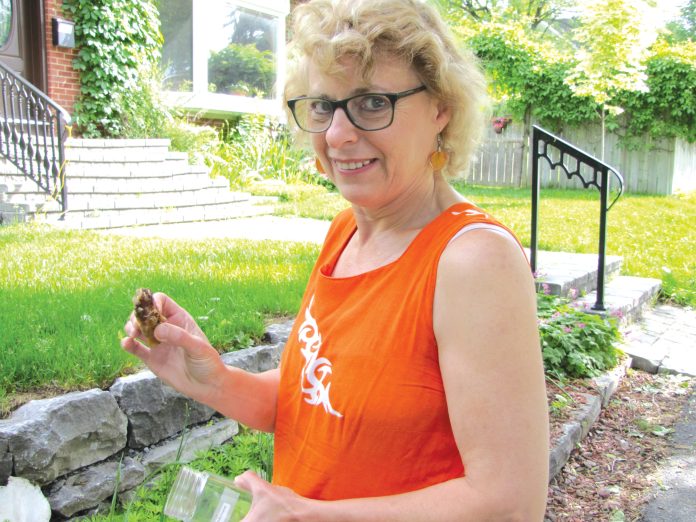By Shaun Markey –
When Debbie Lawes’ son-in-law successfully built a new terraced front garden for her home at 577 Dovercourt Ave., little did she know that it would mark the beginning of a unique outdoor educational initiative that continues to enthrall elementary school age children throughout the neighbourhood.
It started innocently enough when Debbie decided to decorate the new tiered garden with some seashells and a few 350-million-year-old fossils from Blue Beach on the Bay of Fundy. Since the first two tiers of the garden, which stretch across the front of her property, are at eye level of younger pedestrians, they were quick to take notice of the attractive shells.

But the local kids really started to pay attention when Debbie added the skulls and bones of various species of small animals to the garden display – complete with labeled descriptions.
On some days, it is not unusual to see large groups of children stopped on the sidewalk staring intently at the various animal bones on display. The collection includes duck skulls, a rabbit skull, and a squirrel skull and its bony hand. Children are encouraged, via little signs that Debbie has placed in the display, to open the jars and inspect the contents. One mini display in a bottle shows exactly what happens to a mouse when it decides to nibble on an electrical wire. He or she certainly paid the ultimate price to see what plastic wire tastes like. Now that’s a snack with a jolt!

Debbie puts the garden and display to bed in the winter but in the spring she brings out the skeletons, bones and fossils with their labels and jars and begins again. One elementary class from Broadview Public School shows up almost every week, clipboards in hands, to study this front yard skeletal extravaganza.
She recalls a time when a little girl came to her door with her grandmother to ask if she could borrow the skull of a squirrel for a class project. Debbie dutifully turned over the skull. A few days later the skull was returned with a nice thank you note from the little girl.
Debbie says that while many adults are repulsed by the sight of animal skulls and bones, children are not. They are fascinated by the displays and she’s convinced it’s a good thing. “It’s nice to remind children that you don’t have to leave the neighbourhood to learn about wildlife,” says Debbie.
Furthermore, she adds, her displays prompt children to be observant of the natural world in an all too often, as she describes it, “device-addicted society.”
When asked why she would pick up the bones of long-deceased animals she has a quick reply: “Why wouldn’t you? They’re perfectly good skulls!”


As a journalism graduate and a science writer by profession, Debbie comes by her interest in the natural world and wildlife honestly. She notes her daily ritual of walking Bailey, her 11-year-old black Labrador /Border Collie mix, as the source for many of her finds for the display.
Debbie acknowledges a life-long interest in wildlife, an interest which led to her participation as a Director of the Ottawa Carleton Wildlife Centre for 20 years and recent appointment as chair of the Ottawa Valley Wild Bird Care Centre on Moodie Drive. When she stepped down as Wildlife Centre, the parting gift she received, naturally enough, was a very nice raccoon skull.
She recounts an incident that happened to her at 9 or 10 years of age: “There was a robin that fell into the creek and everyone voted that I should be one to go in and get it. We formed a human chain and I was the person at the end that saved the robin. It’s a wonderful feeling to help wildlife.”
Some may think Debbie’s front yard terraces appear to be reaching their limit of display material. Not so, she says firmly. Friends and neighbours stop by routinely with more bones and skulls, all of which she happily accepts and prepares for display. She points enthusiastically to the entire skeleton of a cat – found at the base of the Carlington ski hill – that is almost ready to be included in the display.
At Halloween, Debbie’s display does double duty. “I take a bunch of the skulls and put them in a big pot with a spoon. We shine a light on it. It’s my witches brew!” She estimates that over 200 children get a big kick out of this special exhibit.
Despite all the interesting and cool things in Debbie’s display, very little has gone missing. “We’ve lost a couple of skulls but that’s it. Everyone is respectful.”
When not working on the display and the garden, Debbie and her husband, Mark Henderson, also a professional writer, are busy with numerous writing assignments. Her extended family includes three stepdaughters all of whom live in the Ottawa area.
Always mindful of what’s going on in the community, Debbie was quick to notice the recent controversy over the NCC’s proposal to construct a parking lot from their maintenance yard adjacent to the Ottawa River Parkway in the west end. Debbie wonders aloud if the neighbours might be more inclined to accept a bird sanctuary. As she points out, the Wild Bird Care Centre’s location on Moodie Drive is sadly out of date and needs replacing. A new location close to the water would be ideal.
So, the next time you’re walking in Westboro and happen to come across the bones or skull of a long since departed animal, don’t be repulsed. We know just the spot for it on Dovercourt Avenue where it can join a host of other remains in a display helping to educate the residents of Westboro. Who knows, your simple action might inspire Canada’s next great naturalist.
The KT “Who lives here” series takes a closer look at some unique homes and the people who live there. Which Kitchissippi-area homes are you most curious about? It could be an old home, a new one, a big one, or a small one. Email a street address and a photo to editor@kitchissippi.com and we’ll do the rest. To read other stories in this series, click here.
